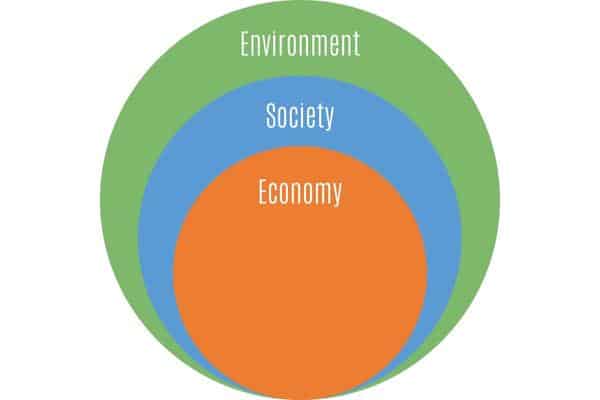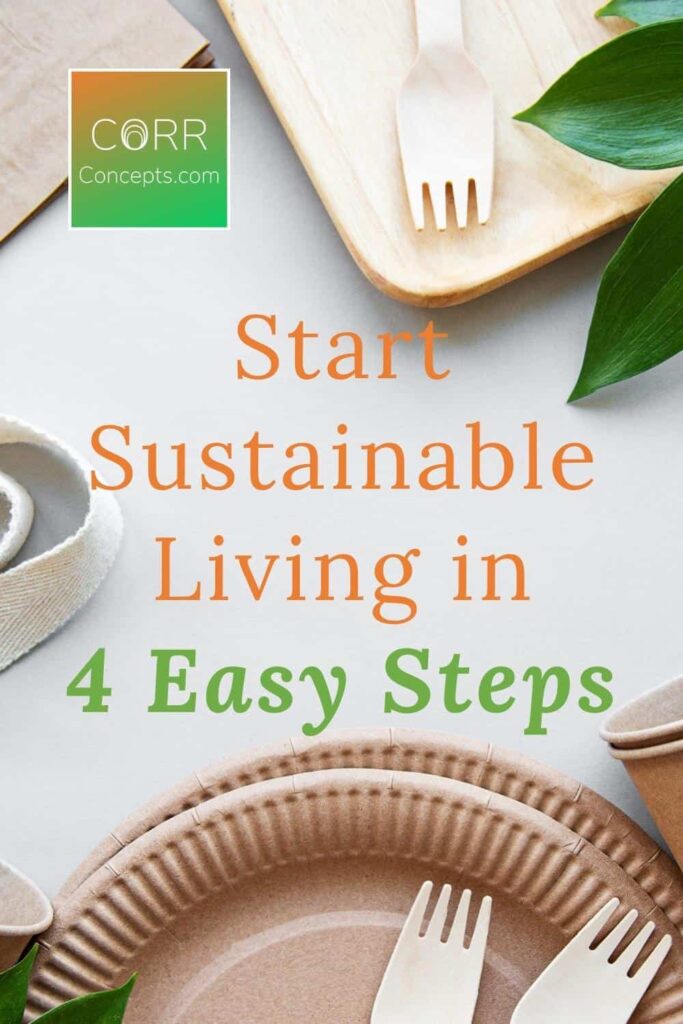
HOW TO LIVE SUSTAINABLY
Learn how to live sustainably and get started creating a sustainability plan towards living more sustainably in four easy steps.
This site contains affiliate links for your convenience. The goal is to first provide links to eco-friendly, ethical, and sustainable brands, and then to those same type brands that use Amazon (i.e., Climate Pledge Friendly Certification), if possible. Therefore, you may see multiple links for one option. Should you make a purchase through any link, I will receive a small commission at no additional cost to you. See my Disclaimers & Disclosures and Privacy Policy for more information.
Like this? Share it with others!
Ready to Learn How to Live Sustainably?
After reading the overview on sustainability, what it is, and why it is important, you’re probably keen to know how to get started to learn how to live sustainably to reduce your impact on global warming, yes? Great!
Now, with trying anything new it helps to first benchmark where you are now. Otherwise, how will you be able to know what your goal is, develop a sustainability plan, and measure how well you’re doing on reaching your goal? Sounds reasonable, right?
Good. This is what you’ll do in working towards a sustainable lifestyle. The first step is to benchmark your current lifestyle by finding out what your current ecological footprint and/or carbon footprint is in order to develop your sustainability plan. “Measure my what?”, you ask?
How to Live Sustainably – Get Started
Let me provide a note here: I recommend calculating at least the Ecological Footprint. I highly encourage you, however, to calculate both footprints so you have a better understanding of where you rank – sustainably wise – in your current lifestyle and have more to measure against as you move through your sustainability plan.
Step 1: Measure Your Ecological Footprint
The Global Footprint Network defines the Ecological Footprint Calculator as measuring “human demand on nature, expressed as a single, easy-to-understand number that’s scalable from an individual to a global level.” Use it to measure your “Ecological Footprint” to discover when in the calendar year your Overshoot Day is and actions you can take to resolve it – with the help of CORR Concepts, of course.
If you want more of an explanation, check out their 6-minute video. The Ecological Footprint Calculator only takes a few minutes to complete with instant, confidential results. It’s also free. Don’t be afraid to put in details to best resemble how you live for a more accurate score.
Your footprint will be measured in global hectares (gha). Hint: we need a smaller ecological footprint than the Earth’s biocapacity in order to be sustainable.
In 2016, the global biocapacity per person was 1.63 gha, but the worldwide ecological footprint per person was 2.75 gha, leaving us with a global deficit of 1.1 gha per person.
You can also see from the link, the U.S. is a major debtor in these calculations with the average U.S. ecological footprint at 8.22 gha per person with only a country’s biocapacity of 3.76 gha. Not good.
What’s your ecological footprint?
Step 2: Measure Your Carbon Footprint
The Carbon Footprint Calculator focuses on your energy, transportation and waste as they contribute to greenhouse gas (carbon) emissions. The calculator can help people figure out how to reduce their carbon emissions and energy costs. There are multiple carbon footprint calculators online, but I am providing a link to the U.S. EPA’s calculator.
This calculator is also free and easy to use, and the results are confidential. To start, get out your last 12 months of utility statements for this one and feel free to use your monthly average over those 12 months. If you do not use your utility bills, you can use the national average, but what fun is there in that?
In all, it shouldn’t take more than 10 minutes to complete the calculator. Download your report so you can refer back to it on the progress you make throughout time (with the help of CORR Concepts).
Carbon (CO2) emissions are measured in CO2 units per metric tons (t) created per year. In 2016, it was determined the global average carbon footprint per person was 4.35 t. In the U.S., however, the average carbon footprint per person was 14.95t! That number has surely risen since.
What is your carbon footprint?
Step 3: Know Your Goal
Give yourself a pat on the back for completing both calculators and measuring both footprints. Even if you calculated only one, still give yourself a pat on the back. It’s a great first step and hopefully you’ll want to measure and track against both footprints as you move forward.
That said, how did you feel about your footprint(s) score? A little scared? Startled? Don’t believe it? Not phased at all?
Whatever your feeling, I say take a deep breath, and don’t focus on what’s a bad score, if you had one. There is no shaming here! CORR Concepts is all about helping make your lifestyle more sustainable.
Just focus on where you’d like to improve. This is knowing your goal(s).
Set realistic goals on what you’d like to improve upon and just move forward. For example, say you eat a lot of red meat and possibly drive your vehicle a little too much and feel these are two areas you can make real improvements. Great. Set reducing those two items as your goals to achieve.
Step 4: Create Your Sustainability Plan
You’ve measured your footprint(s) and know your goals. Now create your sustainability plan on how you’ll achieve your goals and when you’ll complete them.
To provide ease in creating your sustainability plan, I have outlined 6 How To Initiatives, with multiple tips and ideas within each, for you to peruse to help you get started.
Additionally, check out the Sustainability Blog posts, also divided into initiatives plus fashion, that will be continually added so you’re further inspired and equipped to live a sustainable lifestyle. Try those initiatives geared towards your goals and use them daily. Or add new ones daily.
And, yes, you can implement these initiatives into your business.
Last, consult the Conscious Consumer pages for tips on like-minded brands you can use to help you achieve your sustainability plan goals. CORR Concepts is doing the research for you! Only those products and services listed within each environmental initiative, plus fashion, that work towards social or environmental justice or sustainability as a whole will be listed on CORR Concepts so you know these are products and services you can get behind.
Whatever footprint you’ve chosen to measure, and whatever your goals, periodically go back and keep remeasuring your footprint(s) to see if you have improved your score (i.e., reduced your footprint). Yes, it’s that easy.
Go ahead, don’t be afraid. You’ll thank yourself.
Take the Sustainability 101 Challenge
Want to go a step further? Take the CORR Concepts “Sustainability 101 Challenge”, which consists of doing all 3:
1. Use both calculators to measure and benchmark your current footprints.
2. Share this webpage with at least one person so that the sustainability message will spread and enrich us all.
3. Explore CORR Concepts’ Sustainability Initiatives, Conscious Consumer and Blog pages to get information, tips and resources and choose at least one goal in each of the 6 initiatives and implement them into your daily life. Remeasure your footprints until your goals are completed.
BONUS: How sustainable of a lifestyle do you want? After you’ve completed your goals, area you ready to go back and create more goals to tackle?
What are you waiting for?
Measure your eco footprint and carbon footprint today, and move on to the 6 how-to initiatives to start living more sustainably.

